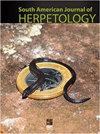两种Liolaemus蜥蜴共享的撤退地点:探索气味的潜在作用
IF 0.7
4区 生物学
Q4 ZOOLOGY
引用次数: 0
摘要
摘要一些蜥蜴物种会根据其他个体的气味来调节对撤退地点的使用,这种行为需要气味识别。在此,我们研究了两种同属同源的蜥蜴(Liolaemus coeruleus的成虫和L. ceii的幼虫)在冬眠前是否能区分彼此的气味。如果异种气味的存在调节了共享撤退地点,物种就会区分彼此的气味。将蜥蜴单独暴露在四种处理中,这些处理是有(1)来自焦点个体(自己)的气味的围栏;(二)与病灶蜥蜴性别相同的同种蜥蜴;(3)与焦点蜥蜴性别相同的异种蜥蜴;和(4)控制(即,外壳与干净的基板)。我们的结果表明不存在异种识别。这一发现不是由于无法对气味进行化学评估,因为这两个物种都表现出自我识别(对自己气味的识别),而且L. ceii的幼崽也表现出同种识别。虽然物种共享撤退地点可能是有利的,但异种气味的化学识别并不调节这些同位物种的这种行为。本文章由计算机程序翻译,如有差异,请以英文原文为准。
Retreat Sites Shared by Two Liolaemus Lizard Species: Exploring the Potential Role of Scents
Abstract. Some lizard species modulate the use of a retreat site based on the presence of scents from other individuals, behavior that requires scent recognition. Here, we investigated if two congeneric and syntopic lizards (adults of Liolaemus coeruleus and juveniles of L. ceii, which can be found sharing retreat sites in the wild) discriminate scents from each other during the pre-hibernation period. If the presence of heterospecific scents modulates sharing retreat sites, species would discriminate each other's scents. Lizards were individually exposed to four treatments, which were enclosures with scents of (1) from the focal individual (own); (2) a conspecific of the same sex as the focal lizard; (3) a heterospecific of the same sex as the focal lizard; and (4) a control (i.e., enclosure with a clean substrate). Our results suggest that there is no heterospecific recognition. This finding was not due to an inability to chemo-assess scents, since both species exhibited self-recognition (recognition of their own scents) and juveniles of L. ceii also showed conspecific recognition. Although it might be advantageous for species to share retreat sites, chemical recognition of heterospecific scents does not modulate this behavior in these syntopic species.
求助全文
通过发布文献求助,成功后即可免费获取论文全文。
去求助
来源期刊
CiteScore
1.50
自引率
0.00%
发文量
10
期刊介绍:
The South American Journal of Herpetology (SAJH) is an international journal published by the Brazilian Society of Herpetology that aims to provide an effective medium of communication for the international herpetological community. SAJH publishes peer-reviewed original contributions on all subjects related to the biology of amphibians and reptiles, including descriptive, comparative, inferential, and experimental studies and taxa from anywhere in the world, as well as theoretical studies that explore principles and methods.

 求助内容:
求助内容: 应助结果提醒方式:
应助结果提醒方式:


